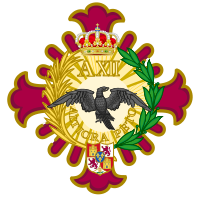Civil Order of Alfonso XII
| Civil Order of Alfonso XII | |
|---|---|
 | |
| Type | State order |
| Established | 23 May 1902 |
| Country | Spain |
| Motto | Altiora peto |
| Status | Abolished 2 September 1988 |
| Founder | Alfonso XIII of Spain |
| Grades |
|
Ribbon of the Order | |
The Civil Order of Alfonso XII (Spanish: Orden Civil de Alfonso XII) is a Spanish honorific decoration named for King Alfonso XII (1857–1885). It was established by Royal Decree on 23 May 1902 to reward achievements in education, science, culture, teaching and research.[1][2]
History[edit]
According to Article 3 of the Royal Decree, the order is composed of three categories: Grand Cross (Spanish: Gran Cruz), Commander (Spanish: Encomienda), and Chevalier (Spanish: Caballero).[1]
Beginning in 1939, the members of the Order could request their entry into the newly created Civil Order of Alfonso X, the Wise.[3]
Royal Decree 954/1988, of 2 September, finalized its replacement with the Civil Order of Alfonso X, the Wise, "adapting its norms to the social conditions of the present time and to the democratic principles on which the legal system is based."[4]
Selected recipients[edit]
- Mariano Benlliure[5]
- Sarah Bernhardt[6]
- Julián Calleja y Sánchez[5]
- Francisco Codera[5]
- Carlos Cortezo[5]
- Marie Curie[7]
- José Echegaray[5]
- Cesáreo Fernández Duro[5]
- Francisco Fernández y González[5]
- Álvaro de Figueroa[5]
- José García Barbón[5]
- José Gómez de Arteche[5]
- Teodoro Llorente Falcó
- Lucas Mallada[5]
- Andrés Manjón[5]
- Carolina Marcial Dorado[8]
- Marcelino Menéndez y Pelayo[9]
- Eugenio Montero Ríos[5]
- José Moreno Carbonero[5]
- José Morer[5]
- Remigio Mugica[10]
- The Orfeó Català[11]
- José María de Pereda[5]
- Benito Pérez Galdós[5]
- Francisco Pradilla Ortiz[5]
- Agustí Querol Subirats[5]
- Santiago Ramón y Cajal[5]
- Arthur Rubinstein[12]
- Eduardo Saavedra[5]
- Vicente Santamaría de Paredes[5]
- Joaquín Sorolla[5]
- Juan Valera y Alcalá-Galiano[5]
- Ricardo Velázquez Bosco[5]
- Pedro Viteri[5]
See also[edit]
References[edit]
- ^ a b "Real Decreto" [Royal Decree] (PDF). Gaceta de Madrid (in Spanish) (152): 953. 1 June 1902. Retrieved 15 November 2018.
- ^ "Reglamento de la Orden civil de Alfonso XII" [Regulation of the Civil Order of Alfonso XII] (PDF). Gaceta de Madrid (in Spanish) (186): 73–74. 5 July 1902. Retrieved 15 November 2018.
- ^ "Decreto de 11 de abril de 1939 creando la Orden de Alfonso X el Sabio" [Decree of 11 April 1939 Creating the Order of Alfonso X, the Wise] (PDF). Boletín Oficial del Estado (in Spanish) (106): 2134. 16 April 1939. Retrieved 15 November 2018.
- ^ "Real Decreto 954/1988, de 2 de septiembre, por el que se regula la Orden Civil de Alfonso X el Sabio" [Royal Decree 954/1988, of 2 September, Which Regulates the Civil Order of Alfonso X the Wise] (PDF). Boletín Oficial del Estado (in Spanish) (216). 8 September 1988. Retrieved 15 November 2018.
- ^ a b c d e f g h i j k l m n o p q r s t u v w x y z Calendario manual y guía de forasteros en Madrid [Manual Calendar and Guide for Foreigners in Madrid] (in Spanish). Imprenta Real. 1904. pp. 778–779. Retrieved 15 November 2018 – via Google Books.
- ^ "Spain Decorates Sarah Bernhardt". St. Louis Post-Dispatch. Associated Press. 21 May 1921. p. 4. Retrieved 15 November 2018 – via newspapers.com.
- ^ Carreras Ezquerra, Miguel (21 December 2011). "Marie Curie, científica universal" [Marie Curie, Universal Scientist]. La Oca Loca (in Spanish). Retrieved 15 November 2018.
- ^ "Miss Marcial-Dorado, Barnard Professor; Head of Spanish Department was Honored by King Alfonso". The New York Times. 26 July 1941. p. 15 – via ProQuest.
- ^ Revista de archivos, bibliotecas y museos, Volumes 6-7 (in Spanish). Montepio del Cuerpo Facultativo del Ramo. 1902. p. 518. Retrieved 15 November 2018 – via Google Books.
- ^ "El 'Orfeón Pamplonès'" (PDF). Boletín Musical (27): 18. June 1930. Retrieved 15 November 2018 – via Ayuntamiento de Córdoba.
- ^ Roig i Rosich, Josep M. (1993). Història de l'Orfeó Català: moments cabdals del seu passat [History of the Orfeó Català: Important Moments of its Past] (in Catalan). L'Abadia de Montserra. p. 70. ISBN 9788478264056. Retrieved 15 November 2018 – via Google Books.
- ^ "Arthur Rubinstein Dies in Geneva at 95". The New York Times. 21 December 1982. Retrieved 15 November 2018.
